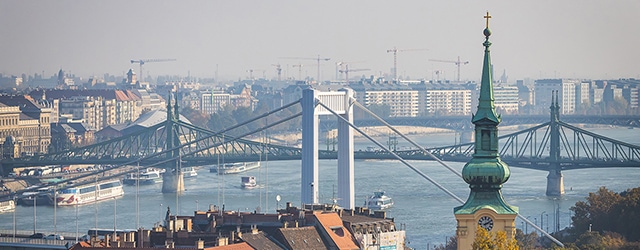A controversial populist regime hasn’t stopped Hungary from outperforming its EU neighbors. But much depends on other EU economies and keeping inflation under control.

Hungary stands apart from most European Union member countries, not just for its populist conservative politics under Prime Minister Viktor Orbán, but also for its relatively buoyant economic performance, with headline GDP growth figures substantially exceeding many other European economies. Real GDP growth in 2018 was 5.1%, according to the European Commission’s Eurostat agency, improving on a 4.3% rate the previous year. That compares favorably to both the overall EU average of 2.6% and Germany’s 1.5% in 2018.
In November, the European Bank for Reconstruction and Development (EBRD) confirmed that the trend has continued, and raised its forecast for Hungarian GDP growth for the full year to 4.6%, slightly lower than the Hungarian government’s own forecast of 4.8%.
That confirms that “the Hungarian economy is still doing great,” says Lajos Török, head of Equity Research and Strategy at Hungarian asset manager Equilor Investment in Budapest. Expectations are that GDP growth “will still be high next year,” he adds, “obviously not 5% high, but in the range of 4% to 4.5%. So we expect this to be slowing a bit, but still growing dramatically in the next few years.”
What’s driving Hungary’s relatively above-par performance? “Hungary, as a whole, relies very much on the macroeconomic development of the eurozone, given its exposure to the car industry and EU funding,” says Hai Thanh Le Phuong, head of Research at Concorde Securities, a leading independent Hungarian investment bank.
The construction and services sectors are also significant contributors, although growth in construction is likely to tail off, Török suggests. “We expect the construction sector to be trending down next year, as VAT for construction services will be higher by the end of the year,” he says. “We expect a significant price increase in the sector.”
Services, however, are likely to stay buoyant, the OECD predicted last month in its Economic Outlook on Hungary: “Private consumption will continue to drive growth on the back of strong gains in real incomes. Public investment will decelerate, along with declining disbursements from EU structural funds.” Domestic drivers supporting growth, according to the OECD, will include “continued solid gains in employment and real wages, an all-time high consumer confidence, housing investment support schemes and very accommodative monetary policy.”
Inflationary Pressures
Hungary remains outside the eurozone, with its own currency, the forint. Currency fluctuations with its close neighbors in the EU can therefore affect the economy significantly. “The Hungarian forint was one of the weakest currencies [of 2019] so far, which obviously helps the export sector,” Török observed in December, “but it can increase inflation if it continues.”
 Le Phuong, Concorde Securities: Hungary relies very much on the macroeconomic development of the eurozone. |
The OECD registers this point as well, noting “low monetary-policy rates, including a negative overnight deposit rate.” Meanwhile, “core inflation has continued to increase, while headline inflation has eased to below 3% on the back of lower energy prices. A weakening of the forint is adding to inflation pressures.” Gradually nudging rates back up “would reduce the risk of overheating and contain inflation expectations.”
Thus far, however, a weak forint has worked in Hungary’s favor. “Currency factors impact inflation, but more importantly, competitiveness,” says Le Phuong. “The recent wage inflation in the country was mitigated by weaker currency and thus Hungary remained more attractive to investors.” Hungary has established itself as a major manufacturing base and parts supplier for Audi, BMW, Bosch and other auto-industry majors. According to figures from the Hungarian Investment Promotion Agency (HIPA), the auto sector accounted for 28.7% of Hungary’s manufacturing output in 2017.
“The main question is how the volatile currency will affect local firms,” says Török. “It is a little harder for companies to create their budgets and expectations for next year.” All the same, “we expect fluctuations to be a small problem for the Hungarian economy.”
Real estate has benefited from the rise in incomes and general economic buoyancy. Eurostat data for the House Price Index in the second quarter of this year, against a baseline of 100 in 2015, put Hungary at 162.46, the highest figure in the EU, compared with 121.10 for Poland and 99 for Italy. Foreign investment demand for properties in Budapest, as well as a drop in the VAT rate on new properties from 27% to 5%, have been significant drivers.
Financial Market Rumblings
Financial markets, too, are spreading their wings. One significant development is last June’s launch of the Hungarian Government Security Plus (MÁP+), a five-year bond that can be purchased and transferred by resident and nonresident individuals, according to Hungary’s Government Debt Management Agency (ÁKK). The reason MÁP+ is attracting so much interest is the offered coupon rate, which begins at 3.75% in the first half of the year of issue, then escalates in annual increments from 4% in the second half to 4.5%, 5%, 5.5% and eventually 6%.
This rate “is very high compared to the average return available through other investments,” notes Török. “That is having a significant cannibalization effect on the financial sector.” By late November, Hungarian households had purchased more than 28 billion florints worth of this so-called “superbond,” while other government securities shrank in volume.
While he predicts that a bond with such a high yield will be sustainable, Török adds, “Obviously, it will be the government’s decision whether to decrease it in the near future.” Previously, he notes, the government decreased the premium on the state’s inflation-linked retail bond from 1.7% to 1.4%. “So maybe that shows the direction for the future.”
In general, “margins, given the global low-yield environment, are expected to remain subdued or trend down,” although in Hungary they will remain above the country’s eurozone peers, Le Phuong agrees.
That extends to the equity market, he adds: “Growth will slow down, but still be solid. As a whole, we expect some decline in return on equity, but still sound fundamentals.”
For Hungarian banks, however, just like those in other countries, the challenge is to respond successfully to the introduction of new, innovative technologies into the industry. “Fintech companies are entering the market,” says Török, citing Revolut, a UK-headquartered retail financial-services provider that now has 250,000 users in Hungary, as a standout example.
“The biggest question in Hungary now in the banking sector is whether MKB, Budapest Bank and the co-ops will manage to merge together to a giant conglomerate in the near future, challenging other big banks,” says Le Phuong.
Of the key domestic players, “the largest one is OTP Bank,” notes Török. “It is the largest company in the Budapest Stock Exchange. The second- and third-largest players are Erste and K&H, which are Austrian and Belgian banks, so the three largest banks are private-sector. Some of the players, like MKB and Takarek Bank, had government backing, but the largest banks are private.”
Politics: Opposition Gains
All across Europe, politics loom large over the economy and financial markets, and Hungary is no exception in this. The October local elections marked one of the most significant upsets of recent years, when opposition parties, exercising an unusual degree of coordination and cooperation in fielding a joint list, scored victories in key cities across the country. Most significant, perhaps, was the result in Budapest, which exercises a disproportionate influence on the entire Hungarian scene. There, Gergely Karácsony, candidate for the opposition Momentum–DK–MSZP–PM–LMP alliance, defeated incumbent István Tarlós of the ruling Fidesz–KDNP coalition to become mayor. In the concurrent Budapest Assembly elections, the opposition alliance gained a majority for the first time in over 15 years.
Could this signal the end of the Orbán era, and a new direction for Hungary? Despite the dramatic opposition gains, Török doesn’t see any significant change, especially in the economic and financial environment, until the next parliamentary elections in 2022.



